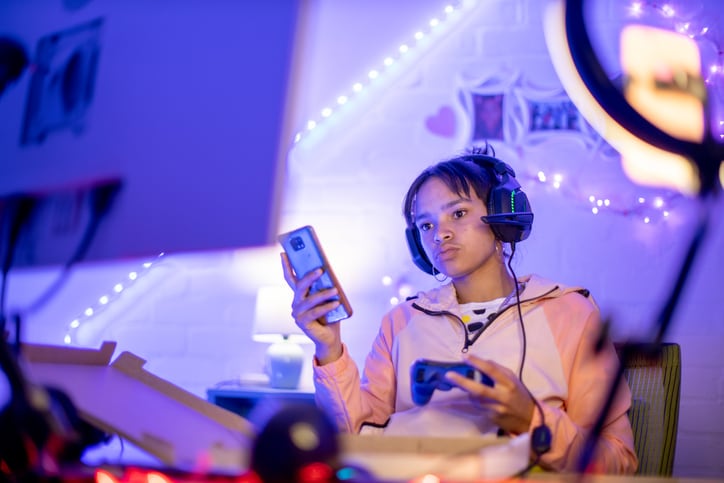It’s no secret that a lot of parents and caregivers struggle to get kids to sleep. Whether it’s the beginning of Daylight Saving Time or just a regular Tuesday night, some babies and young kids can find almost any excuse to battle bedtime. Exhausted parents might try everything from kid-friendly sleep meditations to white noise machines, but one mom says the greatest “sleep hack” she’s found is actually more old fashioned. Emma Sweat, who runs the popular Instagram account Loving Grace Home, says the best sleep her children ever got happened when they were living by candlelight.
“It was during a [power] outage caused by an ice storm and lasted four days,” Sweat writes in a recent post. “We spent all of those days living by natural light and candlelight. We played board games and read books aloud together all day long. After a day of my little boys being trapped inside, we anticipated bedtime being disastrous (it usually was). Much to our surprise, when we put the boys to bed early, they stayed! And they fell asleep quickly!”
Sweat wondered what could be responsible for the big change in her boys’ sleep habits, and she realized the lack of artificial light might be the cause.
“We lived in an apartment at the time that had harsh florescent lighting,” she explains. “In this outage, however, by the time they went to bed, they had been living by dim candlelight for a few hours. This gave their bodies plenty of time to register that it was evening and produce melatonin. It’s no mystery that our artificial lighting and blue lights from screens mess with our circadian rhythms. But it’s one thing to actually experience the benefit of not being affected by those things! It was such peaceful sleep.”
As a result of her family’s experiences during the power outage, Sweat suggests other parents give natural or low light a try. “Try having a candlelight dinner and then reading books before bed by the fireside or candlelight and see how quickly your kids may fall asleep,” she writes. “You might be very surprised.”
Sweat’s post has caught the attention of other parents who struggle with bedtime at home and are eager to give her trick a try. “My word, this makes total sense,” one parent writes. “I’m going to try to implement this in our home ASAP.”
For safety reasons, some have suggested using Edison bulbs or flameless candles to achieve the same effect without any increased fire risk. “We exclusively use warm toned incandescent bulbs only when needed and use only candlelight after sunset,” one parent adds.
So, does natural light actually help kids fall asleep?
Dr. Harvey Karp, a Los Angeles-based pediatrician and the founder and CEO of Happiest Baby, says it’s true that artificial light, like the light from screens or even regular light bulbs, can have the effect of delaying sleep, especially when it’s close to bedtime.
“Exposure to bright light in the hour before night-night can muck up the body’s production of melatonin, the sleep hormone, which can not only delay falling asleep, but also inhibit staying asleep,” Karp says. “While we’re all impacted by before-bed artificial light exposure, children are particularly sensitive. Research on preschoolers shows that melatonin stays suppressed for nearly an hour after lights get turned off.”
For this reason, experts recommend dimming the lights and closing the curtains in preparation for sleep. “About one to two hours before bedtime, it makes sense to lower the intensity of light in the house and also switch to a warmer color of light to promote winding down,” says Heather Turgeon, a California-based psychotherapist and sleep expert with Parent Lab and the co-author of “The Happy Sleeper.”
This trick of lowering the light levels may be especially helpful as parents prepare for the biannual sleep disruption that accompanies the beginning and end of Daylight Saving Time. During time changes, Karp says it’s important to remember to adjust your child’s usual bedtime, in addition to the light levels, to help prepare their bodies for the shift.
“Let’s say your child normally goes to bed at 8 p.m. About four days before ‘springing ahead,’ move their bedtime 15 minutes earlier to 7:45 p.m. and dim the lights at 6:45 p.m.,” Karp advises. “Then, two days before clocks change, shift their bedtime again, this time to 7:30 p.m., with dimming starting around 6:30 p.m. Then on Sunday night, after the clock springs forward, your child will be back to an 8 p.m. bedtime with you dimming the lights around 7 p.m.”
Karp says two to four days is an ideal timeframe to prepare for the beginning or end of Daylight Saving Time, but if you forget about the time change until the last minute, you’re not totally out of luck.
“On Sunday morning, after the clocks have changed, take your child outside for some playtime and stay out as long as you can,” he says. “Doing this allows bigger kids to burn energy, which will help them sleep better at night. At the same time, exposure to morning sunlight helps reset their internal clock and gets them back on track for good nighttime sleep.”






